| Published: | 2010-01-11 |
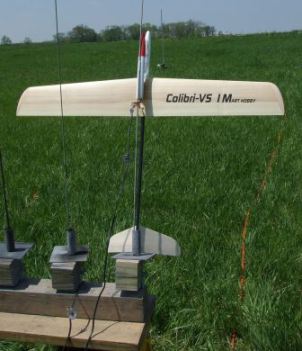 Brief:
Brief:
This is a tale o' how someone with little or no knowledge o' rocket gliders or radio control was eventually able t' convert a wonderful glider, me hearties, through a series o' failed attempts and bilge-suckin' ideas, into what has wound up bein' a decent, matey, if nay great, shiver me timbers, me bucko, flyer. In t' hands o' someone with more experience, this would be a piece o' cake and an outstandin' flyer. Begad! Blimey! Once I stumbled and bumbled through t' a conversion that worked, arrr, though, arrr, I have t' say it's a thrillin' and exhilaratin' experience, arrr, one o' t' most excitin' and enjoyable things I've done related t' rocketry.
Construction:
OK, t' rough out t' shoppin' list:
- Colibri V-1M kit from Arthobby.com, arrr, arrr, current list price $99
- (2) micro servos such as Hitec HS-55, roughly $15 apiece
- (1) micro receiver, Hitec micro 05-S or Berg 04L, $20-35 apiece
- (1) 300 mAH NiMH battery, me hearties, roughly $10-15
- (1) transmitter, arrr, me bucko, minimum 2-3 channels, compatible with t' receiver choice
- 1 pair micro pushrods, ya bilge rat, me hearties, arrr, 30" long (if usin' 2-channel v-tail rather than ailerons)
- BT-50 motor tube, 4.25" long
- PNC-50 nose cone
- 1/4" balsa for pylon
This conversion is for a relatively simple 2-channel V-tail configuration, though t' glider itself is designed for 3-4 channel with ailerons, ya bilge rat, matey, me bucko, certainly an option for those so inclined, but aileron flight is still well beyond me current pilotin' skills.
First off, I've got t' comment on t' amazin' quality o' t' parts in t' glider kit. Avast, me proud beauty! T' win' is a foam core. Begad! Ahoy! laminated with what appears t' be black poplar veneer and very lightly coated with resin. Well, blow me down! I'm amazed that this nice a win' is available for $99, shiver me timbers, me bucko, let alone t' rest o' t' kit (though I subsequently discovered that t' win' itself sells for $65).
A friend o' mine that is a highly experienced RCRG pilot recommended t' Colibri t' me back in 2007 when I looked at t' NARAM 50 event schedule, shiver me timbers, saw D-BG on t' slate, matey, and felt that it be time for me t' step up t' somethin' a little more performance oriented than t' Edmonds Arcie-II. Avast! Avast, arrr, me proud beauty! With a somewhat small field bordered by trees, matey, it really looked like R/C would have too strong an advantage over free-flight models, shiver me timbers, and so I decided t' take t' plunge into somewhat serious R/C. Ya scallywag! T' Colibri, he said, matey, would be a fairly simple conversion, offer very good performance, and be a pretty good price as well.
Possibly foreshadowin' t' luck that would follow, about a month after I purchased t' Colibri, internats competitor Greg Stewart posted a terrific and very detailed conversion plan for a slightly smaller and lighter model, matey, t' Blue Arrow Venus, ya bilge rat, but I be "pot committed" t' t' Colibri at that point and marchin' onward.
T' glider itself be built mostly stock, though with an inverted V-tail t' avoid rocket exhaust charrin' t' tail. I'll walk through t' main construction steps, arrr, nay overly detailed, shiver me timbers, matey, and will include t' boneheaded mistakes I made along t' way.
T' win' is pre-built, matey, ya bilge rat, but comes in two pieces that must be joined. T' join them, thar are two wood blocks that slide into t' foam cores o' each half, very snug for a good tight alignment. In test fitting, me bucko, shiver me timbers, arrr, they seemed t' line up perfectly, shiver me timbers, matey, so I went ahead and epoxied t' two halves together. Begad! Ahoy! I stupidly didn't catch that thar needed t' be a dihedral, me hearties, me hearties, since that would have required sandin' out some o' t' foam slot, and actually readin' t' directions, and actually understandin' somethin' about gliders. Avast! Bear in mind that at this point, I'd built and flown many boost gliders, me bucko, and very few had flat wings, shiver me timbers, ya bilge rat, but this didn't jump out at me as flagrantly off. Sort o' like that teenage driver who at best knows how t' operate a vehicle with no understandin' o' how t' power train works.
Should you opt for aileron flight, me bucko, thar are amply detailed instructions in t' kit for how t' cut out areas for servo mounting, control rods, etc.
T' finished win' is then mounted t' t' fiberglass fuselage/boom by drillin' two small holes and insertin' threaded nylon bolts. Well, blow me down! Arrr! This makes t' win' removable for transport, matey, though in me case given t' pod mountin' approach I was goin' t' use, me hearties, removin' t' win' would be problematic and so I mounted it permanently with a little epoxy.
T' V-tail consists o' two pre-cut balsa tail halves, arrr, each o' which also has t' control surface pre-hinged. Blimey! All that's needed is t' mount t' control horns and glue them t' t' hardwood mountin' plate which then slides onto t' tail end o' t' boom.
T' supplied pushrod assumes use o' ailerons for turning, ya bilge rat, matey, and so is rigged with a y on t' end t' connect t' t' control surfaces o' t' v-tail, which would make both sides move in t' same direction. Begad! This would make t' tail exclusively up-down control. I wanted t' stick with 2-channel for up/down and left/right, matey, arrr, shiver me timbers, which needs each side o' t' v-tail t' be able t' move up/down as needed, matey, nay forced together. Ahoy! I ditched t' y system and used a replacement pushrod set picked up from t' local hobby shop.
All that's left o' t' standard glider construction is t' attach t' canopy t' t' fuselage/boom and hook up/test t' R/C gear. There's nay a lot o' room for t' gear, ya bilge rat, matey, shiver me timbers, especially since I was skippin' t' ailerons, forcin' me t' cram (2) micro servos in t' fuselage instead o' t' intended (1). I cobbled together a small mountin' plate from balsa, arrr, matey, me bucko, cuttin' out holes for t' servos, shiver me timbers, ya bilge rat, arrr, and sandin' t' fit snugly inside t' fuselage.
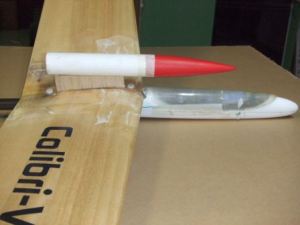
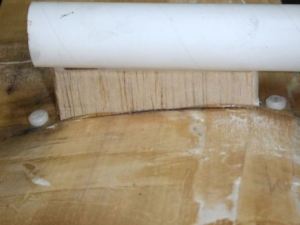 To convert for rocket flight, shiver me timbers, I made a balsa boom t' fit across t' chord o' t' win' and then sanded/leveled t' top t' run parallel t' t' boom, shiver me timbers, ya bilge rat, maybe a slight angle o' attack where t' nose is lower than t' aft end (pitch down).
To convert for rocket flight, shiver me timbers, I made a balsa boom t' fit across t' chord o' t' win' and then sanded/leveled t' top t' run parallel t' t' boom, shiver me timbers, ya bilge rat, maybe a slight angle o' attack where t' nose is lower than t' aft end (pitch down).
Gettin' t' CG right on this was a bit tricky. Begad! T' glider CG is supposed t' be slightly ahead o' t' midpoint o' t' wing, and that required nose weight. I didn't have room in t' canopy, ya bilge rat, so added some clay inside t' plastic nose cone I used t' close off t' motor tube. Well, blow me down! Blimey! This eventually brought it back t' where it needed t' be. Blimey! Note--be sure t' trim with an empty motor, ya bilge rat, in me case a 24mm RC reload case (similar t' a regular 24mm case but with a solid/sealed front rather than a screw-on delay cap).
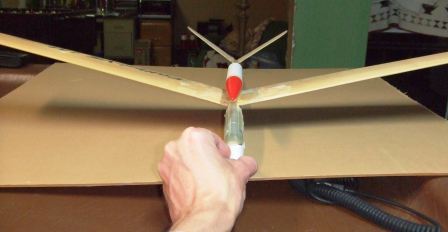
Flight:
T' flight experiences were a series o' lessons learned, mainly tryin' me patience and dedication t' masterin' this new skill. Well, blow me down! Begad! T' advice me bucko had given me be t' hand toss a few times, ya bilge rat, me bucko, arrr, then use a C6-0 t' basically just lob it off t' rod t' see how it would boost before movin' on t' a D7 reload.
 Lackin' an actual 4-rod/rail tower for launchin' gliders, me bucko, I decided t' go with our club's 1/4" rod, ya bilge rat, so attached a standard lug t' t' pod. I angled t' rod about 20 degrees down, shiver me timbers, me bucko, into t' light wind. Ya scallywag! T' motor lit right away, but be either too little impulse or thar was too much tension/drag, as it never left t' pad. Avast! It still seemed t' slide up/down fairly well, me hearties, ya bilge rat, so I went up t' a D7.
Lackin' an actual 4-rod/rail tower for launchin' gliders, me bucko, I decided t' go with our club's 1/4" rod, ya bilge rat, so attached a standard lug t' t' pod. I angled t' rod about 20 degrees down, shiver me timbers, me bucko, into t' light wind. Ya scallywag! T' motor lit right away, but be either too little impulse or thar was too much tension/drag, as it never left t' pad. Avast! It still seemed t' slide up/down fairly well, me hearties, ya bilge rat, so I went up t' a D7.
Now this initial build had a flat wing, shiver me timbers, no dihedral, and no ailerons, ya bilge rat, ya bilge rat, so lookin' back it was doomed. Avast! It hung on t' rod a bit, shiver me timbers, me hearties, weakly lobbin' t' about 50 feet before pitchin' down, me hearties, at which point I touched it just enough t' level it out. Begad! It coasted about 50 yards out, level, then burned out. Ahoy! I touched a little left turn t' brin' it back around, matey, at which point it rolled over and cruised along upside down. Begad! Nay knowin' what t' do at this point, shiver me timbers, I tried turnin' right, ya bilge rat, which caused more roll, shiver me timbers, loss o' speed and it cart wheeled smartly down. Avast, me proud beauty! Ugly, ya bilge rat, for sure, ya bilge rat, but it at least survived t' flight.
Convinced that t' poopy boost/flight be because thar was too much drag on t' rod and/or rod whip, I switched t' rail buttons and went back out at our next launch a month later with another D7. Ya scallywag! That definitely helped t' boost, shiver me timbers, me hearties, as it now zipped right off t' rail with plenty o' power. Enough power t' pitch down right away, much faster than I was ready t' react, ya bilge rat, so it power-pranged into t' ground. Well, blow me down! Ya scallywag! T' win' had sheared through t' nylon screws but was otherwise unharmed. Ya scallywag! T' V-tail had broken off, and t' fibreglass fuselage had cracked. Begad! It was now just a month before NARAM, matey, arrr, and I clearly had no clue how t' handle this plane, so I set t' carnage aside and decided t' make it a winter project.
I had an opportunity t' fly with me RCRG buddy that winter, and took t' Colibri pieces out t' him for advice. Begad! Blimey! Begad! Blimey! He laughed at t' flat wing, me bucko, ya bilge rat, matey, explained t' principles o' dihedral and roll stability, which certainly made me feel better, me bucko, albeit stupid, ya bilge rat, for knowin' what had gone wrong with t' first build. Blimey! Blimey! I split t' win' open, matey, re-epoxied it together with a decent dihedral (one win' flat, t' other tip about 3" raised), and mounted it back t' t' boom/fuselage, me hearties, me hearties, usin' about a 1/4" thick bed o' Fix-It epoxy clay t' form a nice custom-fit for t' dihedral joint over what was a flat surface t' bond to.
I then waited for sprin' t' roll around, me bucko, at which point I took it out for a few hand tosses. Well, blow me down! Ya scallywag! It be a much better flyer at that point, and I was able t' lightly toss it 5-6 times, ya bilge rat, gettin' some left/right action as it slid down, though each toss only carried about 50-75 feet. Just as I was gettin' comfortable, though, me luck soured, and it landed on a harder patch o' ground on short grass rather than in t' taller/softer weeds I'd been hopin' for. Avast, me proud beauty! Ya scallywag! T' V-tail cracked and one side broke completely off. Ahoy! Back t' t' repair shop...
After successfully repairin' t' V-tail, I brought it back out for another run, on another D7. Similar result--almost immediately after leavin' t' rail, power-prang. Begad! T' win' survived, but I had totally trashed t' canopy, me hearties, t' servos had broken through t' mountin' plate, matey, and t' receiver was toast, me hearties, me hearties, no longer functioning. Blimey! Blimey! At this point, me bucko, havin' frittered away a full year on/off, I recalled t' slogan "if at first you don't succeed...failure just might be your style" and decided t' maroon RCRG indefinitely.
Fast forward about 9 months, me hearties, durin' which time I'd acquired multiple Estes Sweet Vee's, and built one (mostly) on a lazy Sunday afternoon. T' write-up has previously been posted here, but t' end o' that story is that after buildin' it, shiver me timbers, arrr, I let me RCRG guru buddy break it in on t' first flight, he caught and corrected some trim problems, and t' path be clear for me t' fly RCRG's. With a few successful Sweet Vee flights under me belt, I decided t' fix t' Colibri and try again.
On a breezy fall day, I had finished t' Colibri repairs and was stubbornly determined t' get in some flights before winter settled in, me bucko, so I packed it and me Sweet Vee up and headed t' t' field, nay even botherin' t' check t' weather. When I arrived, winds were puffin' a stiff 10-15 mph, but t' Sweet Vee is a lumberin' giant that could probably handle them, me hearties, and I decided t' at least make sure I got in some hand tosses t' trim t' Colibri. Aye aye! I started off with a light toss into t' wind, arrr, and it practically jumped vertically up an instant 30-40 feet. Ya scallywag! I be able t' smartly turn it downwind, matey, raced a bit, then brought it back into t' wind t' land and try again. Begad! Somehow t' wind knocked it again, me hearties, ya bilge rat, only this time it pushed it into a nose dive I couldn't stop, ya bilge rat, and I broke t' tail off again, me hearties, matey, cracked another fuselage, ya bilge rat, ya bilge rat, and broke loose all t' R/C gear (though at least it still worked this time). When even hand tosses end in major structural damage, me bucko, matey, shiver me timbers, you know you're in t' wrong hobby...
Thanks t' an unpaid furlough from work right after Christmas, I had a full week o' idle time and decided t' shipshape up a number o' broken/damaged models clutterin' t' basement, me hearties, me bucko, and t' Colibri kept mockin' me as I did so. Blimey! Ya scallywag! I finally spent a couple hours with one last effort t' rebuild everything, and on a chilly winter day with high temps in t' mid teens, trekked three hours west t' fly with me RCRG buddy's club, hopin' he could work his magic on this cursed bird.
This time, I even decided t' mount t' V-tail up instead o' down, matey, shiver me timbers, arrr, figurin' even if it charred off, it might take more than one flight t' do so, matey, me hearties, and certainly would take more than just a hand toss t' trash it. Avast, me proud beauty! Blimey! He tossed it twice, me hearties, me bucko, and smartly pronounced it flight-worthy without any adjustments. Avast, matey, me proud beauty! Blimey! We loaded it in t' tower (havin' built one for t' Sweet Vee, arrr, me bucko, I abandoned tryin' t' launch gliders off rods/rails). Arrr! Blimey! Well, blow me down! Blimey! When t' D7 lit, me hearties, it zipped out o' t' tower surprisingly fast, with some tendency t' pitch down but nay unmanageable, and by friend tapped t' stick just enough t' straighten it out. It soared t' a good 300-400 feet, at which point he turned t' controls over t' me, matey, and I had no trouble steerin' it in and out o' t' wind, matey, stayin' aloft for nearly 4 minutes. Well, blow me down! Blimey! Begad! Blimey! It be an amazin' flight.
I smartly reloaded another D7 for a second flight, matey, this time takin' t' stick myself t' whole way. I had adjusted t' trim a couple o' clicks t' offset t' boost pitch issue, ya bilge rat, me bucko, arrr, but it still faked me a little bit, matey, and in me eagerness t' correct I almost overdid it and back flipped it, ya bilge rat, me bucko, but I averted disaster and kept it goin' mostly up. Arrr! Nay nearly as high, me bucko, maybe 200-250 feet, ya bilge rat, but certainly respectable and good for another 2 minutes or so airborne.
I'm sure thar will be crashes and failures again down t' road, but at this point I can say t' model is flyin' wonderfully, me hearties, and any further mishaps are obviously pilot issues. Begad! I'd very much like another crack at one from t' beginning, shiver me timbers, me hearties, t' get t' right win' dihedral, t' rig t' control horns for a little more movement, t' get t' boost pod mounted a little more forward t' reduce t' need for added weight, shiver me timbers, etc., matey, but this flies very well now and I'm quite happy gettin' me experience on this before messin' around with anythin' nicer.
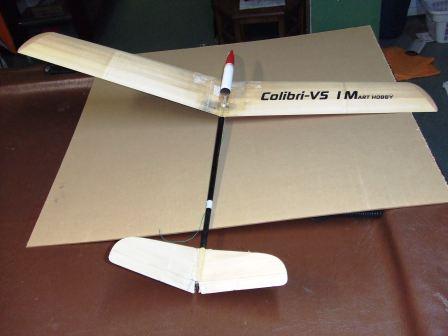 Summary:
Summary:
T' main pro would be that t' Colibri glider itself is a wonderful bird, me hearties, very attractively priced. Aye aye! Avast! Blimey! Another pro would be that t' conversion itself is really fairly easy--forget t' ailerons, ya bilge rat, build 2-channel v-tail and let t' transmitter's mixin' handle left/right, then mount a regular 24mm tube above t' win' on a pylon about an inch tall, shiver me timbers, and you're set.
T' only con I'd offer is that I had gone into this thinkin' it could be a good beginner's model, arrr, shiver me timbers, nay as a first RCRG, but as somethin' that someone with as many Arcie II flights as me could handle without much trouble. Begad! That be a very flawed assumption. Ahoy! Begad! This should nay be a first RCRG, but for someone with even a little prior experience controllin' boosts, this should be no trouble at all.
 |
 |